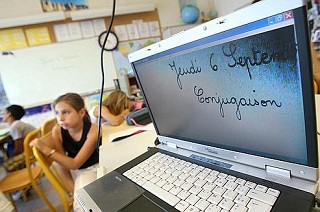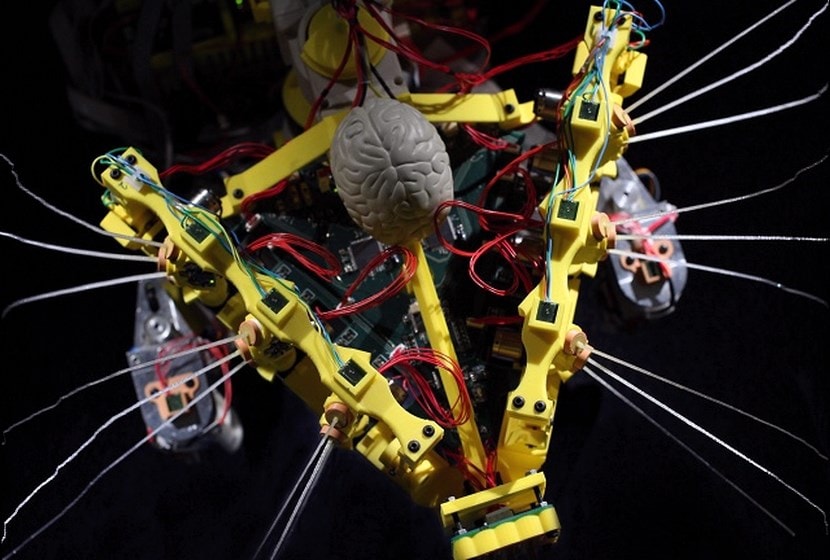We are increasingly entering the era of digital education. This education is based on information and communication technologies, the foundation of which is the digitisation of content. The development of ICTs has brought us into a truly global information space in just a few decades. The knowledge economy, identified as one of the main levers of competitiveness, has become an object of international competition.
Several recent developments should be taken as opportunities for digital development.
In higher education, examples include the creation of research and higher education clusters (PRES), the LRU law, the Campus operation / UEB C@mpus project in Brittany, the 2012 digital plan. The profound changes brought about by all of these reforms provide an historic opportunity to rethink its digital strategy. Digital teaching platforms, dedicated sites, digital universities, ENTs (Digital Workspace) exist, whether in the field of education or in that of business.
Digital training in companies
Digital education does more than simply provide knowledge to individuals. It helps companies to acquire essential collaborative methods, it encourages the birth of technical innovations, it allows to capitalize on knowledge.
The benefit of digital education for businesses as such is not negligible. Distance learning makes it possible to disseminate in parallel the method and the knowledge initiating collaborative work methods in the company. It teaches a way of working together, it accompanies the company in the management of its knowledge.
In a way, the training of its employees makes the company "learning". We train individuals, we teach the company to create its tools. We go beyond the first level objectives, such as the comfort of not having to travel or flexibility in schedules. It is an objective that can be described as "meta", beyond the primary function of training.
This second function of training is important in a world where organization is increasingly one of the company's performance criteria. However, this organization can hardly be done without the digital tool, if only because the new generations entering the company are born with digital technology.(Source: Le Monde " Bâtirons une planète plus intelligente "- 2011)
Encouraging innovation, ensuring conservation
The training process can also foster the emergence of innovations that will be valuable for the development of the company. Take the example of the CNAM who, in an interview for the newspaper Le Monde, explains: "Let's take the case of a training course that we provide on an ongoing basis, that of nuclear plant decommissioning techniques. When we train the engineers who are working on this task, or who aspire to work on it, we often end up with innovative projects. Everyone expects the CNAM not only to support the company in increasing its skills, but also to teach it to "think outside the box". The dismantling business has to be invented, it is new, and there are no ready-made answers. Distance learning, collaborative work and contact with the academic world help to set this innovation process in motion.
Finally, because we are the CNAM, I also want to stress the "preservation" function of knowledge. As a "conservatory", we are committed to keeping a clear trace of the knowledge taught, to "capitalize" on it. The capitalization in the minds of our teachers can go with our teachers.
With digital technology, we can easily keep knowledge, not like in a museum, but as a building block for our future teaching".
Digital learning resources: the future of education?
The challenge for education is to adapt teaching methods to today's students, without making concessions in terms of content and thus connect schools, colleges, high schools, universities, ... to the digital world. This means making better use of technology by creating more videos and animations and by associating certain exercises with different media, such as discussion forums and blogs. "You have to be able to think the way students think. Students are happy to work online, moving from static pages to videos and listening to podcasts. We need to use these capabilities when we create digital content," says Erik van Noordenne, sales manager at da Vinci College.
For many head teachers, this leads to a better quality of education. Teachers do not have much time, but many create their own digital resources. By finding the teaching materials they already need on the learning platform, they have more time to do what they do best: teach."
Today, nearly one teacher in five uses a digital textbook, a sign that their use is "gaining ground" in the French education system, reports a TNS-Sofres survey of 6,183 teachers conducted from 10 June to 11 July 2011. For teachers, nothing will prevent the digital boom. To date, there are 950 different digital textbooks. "Since 2009, each textbook has been systematically bimedia [paper and digital] and equipped with advanced interactivity [video projection, ergonomic navigation, tools for interaction with the classroom]. But "despite an increase compared to 2010, digital textbooks represent less than 1 % of printed textbook sales," says Savoir Livre and the School Publishers Group.
A concrete example, that of the company Speechi which has just created the first collaborative teaching software called Alexandra. Since 2004, Speechi has been supporting teachers, from nursery school to higher education, to make teaching a course more practical, more fluid but also innovative in terms of pedagogical method. The company has developed a range of solutions combining software and hardware (interactive whiteboards, etc.). (Smart Board)The aim is to make education resolutely nomadic and digital, using a variety of equipment (computers, visualizers, mobile classrooms, video projectors, etc.). Whether in the classroom or at a distance, the teacher has access at all times to didactic presentations that he or she has designed to facilitate the learning of his or her students by associating multimedia content.
This collaborative e-learning platform now allows teachers to create their courses, but also to broadcast and share them on the Internet. For their part, students can enrich them with comments, directly or a posteriori, and share them in turn. Teaching thus becomes interactive and collaborative. When form does not take precedence over substance.
Another example, in learning music: taking acoustic, classical, electric, bass guitar, piano, harmonica, drums lessons in video is now possible thanks to iMusic-School. They are artists recognized in their style who invite themselves in your home to transmit to you what makes their originality, and to share with you their pleasure of playing. With more than 12,000 videos accessible at all times, iMusic-School has become the first music school on the Internet, and now allows you to learn the main instruments: guitar, piano, vocals, bass, drums, etc... More than 10,000 students have learned music thanks to this method, making iMusic-School the reference for online music learning in just 3 years. Last information of the day: with a score of 94%, the Facebook page of iMusic-School ( http://www.facebook.com/imusicschool), ranks second in the ranking on the rate of responses to questions from Internet users, ahead of IDTGV, Auchan Drive, Eram...
The site offers a dense and quality support that allows you to progress at your own pace: a unique teaching method integrating videos, course materials (drawings, scores...), playbacks, as well as music theory and harmony lessons. Through this pedagogical, artistic and playful approach, iMusic-School accompanies all those who wish to learn to play an instrument or to improve their skills, benefiting from the experience of renowned musicians who transmit technical know-how as well as artistic openness. Reciprocally, these music courses allow artists/musicians to establish a privileged and direct relationship with their public based on the transmission of their own musical creation.
The user benefits are numerous. First of all, for the teacher, because he has tools that allow him to design complete courses, in interaction with his class. Students can be given immediate answers thanks to the integrated web resources. He also has the possibility to draw inspiration from courses published by other teachers.
For the student, of course, because the multimedia content allows him/her to assimilate the lessons in a different way, complementing the classical teaching. Putting the courses online gives them the opportunity to revise parts of the course without having to find their handwritten notes.
There are of course other solutions dedicated to teaching. Like Open-Sankoré In addition to annotating, drawing and highlighting, this software offers the possibility of enriching the content of your course by importing flash animations, images, sound, videos or integrating existing .pdf or .ppt documents. Moreover, it is free and open source.
The digital divide must therefore be bridged
The digital development of a territory requires the implementation of online public services for education, providing personalized services to students and disseminating to the greatest number of people the contents representing the scientific quality of the University.
Digital technology is an area that is in line with Objective 1 of the LOLF Higher Education and Research: "Promote equal access to higher education training for different social classes".
Each university is thus led to define its policy for responding to the risk of a digital divide between students according to their environment. The stakes for teaching are high: building a strong brand image, by gaining international visibility and maintaining its regional attractiveness; satisfying its users and stakeholders, by striving to meet the objectives, missions and needs of students, teachers, researchers, staff and management of the institution and mastering the digital knowledge chain, by promoting the generation of digital content. To do this, knowledge management must be organized and industrialized by defining the dissemination policy, and finally, the intellectual heritage must be enhanced.
Innovative solutions for successful digital schooling
The report of the Fourgous mission in 2010 demonstrated the role of digital technology, an effective tool in the fight against school failure and a factor of equal opportunities, in school success. Although this report is far from being the first of its kind on the subject, it has the merit of relaunching the debate, which is indeed necessary, on schools in the digital age, and in particular of calling for a comprehensive and ambitious policy in this area, which cannot be reduced to the question of equipping schools and pupils, or to that of media education. It also highlights the financial needs of more than one billion euros to catch up with France in this area (France ranks 8th in Europe in terms of equipping schools with ICT, and only 24th out of 27).
Based on more than 12,000 contributions and testimonials, the report gave a voice to all digital stakeholders: teachers, students, management staff of the French National Education system, parents, trade unions, economic decision-makers, manufacturers and publishers. This report provides a precise overview of the experiences carried out in France and compares them to the policies implemented abroad. The introduction and generalisation of ICTE (Information and Communication Technologies in Education), desired by the educational community, has a considerable impact on the role of the teacher and pedagogy at all levels: school time, exams, textbooks, curricula...They also lead to making scientific subjects and foreign language learning more attractive.
In order to strengthen this deployment throughout the country, the report recommends 12 priorities and 70 measures, including :
The connection of 100% of schools to broadband by 2012, then to very high speed, and the generalization of interactive digital boards.
Training of teachers by the National Education in digital tools and services.
The creation of interactive spaces in schools and new interactive media and innovative digital textbooks.
The development of ENTs (Digital Working Environment).
The development of digital tools to strengthen creativity, autonomy and self-confidence.
The creation of a light and operational structure for steering and driving digital technology in schools.
Read more :
- Article in Le Point " L'école numérique de Chatel " : http://skhole.fr/sites/default/files/rapport-fourgous-chatel-TICE.pdf
- Actions of France in the field of education / Creation of a distance higher education system : http://www.diplomatie.gouv.fr/fr/pays-zones-geo/haiti/haiti-deux-ans-plus-tard/actions-de-la-france-dans-le/article/creation-d-un-dispositif-d
- Digital Work Environment / Education goes online : http://www.connexions-normandie.fr/environnement-numerique-travail-enseignement-universite-normandie/1620/
- The pedagogical café: http://www.cafepedagogique.net/lexpresso/Pages/2012/03/08032012Accueil.aspx
- Book: "School, digital and the society to come": http://arsindustrialis.org/l%C3%A9cole-le-num%C3%A9rique-et-la-soci%C3%A9t%C3%A9-qui-vient-sortie-le-25-janvier-2012
- The Digital Education Review
To extend online :
– The presidential campaign as seen by Bernard Stiegler to understand that digital education in schools is part of a more global project of "economy of contribution".
- The site Ars Industrialis












